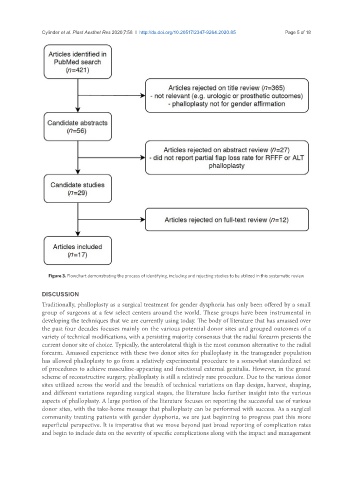Page 671 - Read Online
P. 671
Cylinder et al. Plast Aesthet Res 2020;7:58 I http://dx.doi.org/10.20517/2347-9264.2020.85 Page 5 of 18
n
n
n
n
n
n
n
Figure 3. Flowchart demonstrating the process of identifying, including and rejecting studies to be utilized in this systematic review
DISCUSSION
Traditionally, phalloplasty as a surgical treatment for gender dysphoria has only been offered by a small
group of surgeons at a few select centers around the world. These groups have been instrumental in
developing the techniques that we are currently using today. The body of literature that has amassed over
the past four decades focuses mainly on the various potential donor sites and grouped outcomes of a
variety of technical modifications, with a persisting majority consensus that the radial forearm presents the
current donor site of choice. Typically, the anterolateral thigh is the most common alternative to the radial
forearm. Amassed experience with these two donor sites for phalloplasty in the transgender population
has allowed phalloplasty to go from a relatively experimental procedure to a somewhat standardized set
of procedures to achieve masculine-appearing and functional external genitalia. However, in the grand
scheme of reconstructive surgery, phalloplasty is still a relatively rare procedure. Due to the various donor
sites utilized across the world and the breadth of technical variations on flap design, harvest, shaping,
and different variations regarding surgical stages, the literature lacks further insight into the various
aspects of phalloplasty. A large portion of the literature focuses on reporting the successful use of various
donor sites, with the take-home message that phalloplasty can be performed with success. As a surgical
community treating patients with gender dysphoria, we are just beginning to progress past this more
superficial perspective. It is imperative that we move beyond just broad reporting of complication rates
and begin to include data on the severity of specific complications along with the impact and management

